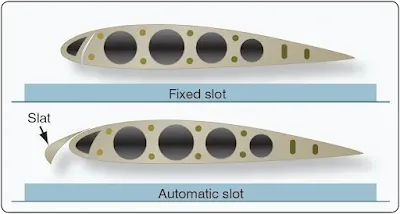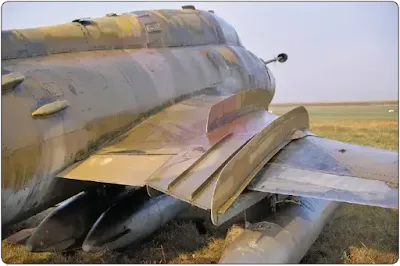Included in the auxiliary lift devices group of flight control surfaces are the wing flaps, spoilers, speed brakes, slats, leading edge flaps, and slots. The auxiliary groups may be divided into two subgroups: those whose primary purpose is lift augmenting and those whose primary purpose is lift decreasing. In the first group are the flaps, both trailing edge and leading edge (slats), and slots. The lift decreasing devices are speed brakes and spoilers.
Lift Augmenting
Flaps are located on the trailing edge of the wing and are moveable to increase the wing area, thereby increasing lift on takeoff, and decreasing the speed during landing. These airfoils are retractable and fair into the wing contour. Others are simply a portion of the lower skin which extends into the airstream, thereby slowing the aircraft. Leading edge flaps, also referred to as slats, are airfoils extended from and retracted into the leading edge of the wing. Some installations create a slot (an opening between the extended airfoil and the leading edge). [Figure 1] At low airspeeds, this slot increases lift and improves handling characteristics, allowing the aircraft to be controlled at airspeeds below the normal landing speed.
 |
| Figure 1. Types of wing flaps |
Other installations have permanent slots built in the leading edge of the wing. At cruising speeds, the trailing edge and leading edge flaps (slats) are retracted into the wing proper. Slats are movable control surfaces attached to the leading edges of the wings.
When the slat is closed, it forms the leading edge of the wing. When in the open position (extended forward), a slot is created between the slat and the wing leading edge. At low airspeeds, this increases lift and improves handling characteristics, allowing the aircraft to be controlled at airspeeds below the normal landing speed. [Figure 2]
 |
| Figure 2. Wing slots |
Lift Decreasing
Lift decreasing devices are the speed brakes (spoilers). In some installations, there are two types of spoilers. The ground spoiler is extended only after the aircraft is on the ground, thereby assisting in the braking action. The flight spoiler assists in lateral control by being extended whenever the aileron on that wing is rotated up. When actuated as speed brakes, the spoiler panels on both wings raise up. In-flight spoilers may also be located along the sides, underneath the fuselage, or back at the tail. [Figure 3] In some aircraft designs, the wing panel on the up aileron side rises more than the wing panel on the down aileron side. This provides speed brake operation and lateral control simultaneously.
 |
| Figure 3. Speed brake |
Winglets
Winglets are the near-vertical extension of the wingtip that reduces the aerodynamic drag associated with vortices that develop at the wingtips as the airplane moves through the air. By reducing the induced drag at the tips of the wings, fuel consumption goes down and range is extended. Figure 4 shows an example of a Learjet 60 with winglets.
 |
| Figure 4. Winglets on a Bombardier Learjet 60 |
Canard Wings
A canard wing aircraft is an airframe configuration of a fixed wing aircraft in which a small wing or horizontal airfoil is ahead of the main lifting surfaces, rather than behind them as in a conventional aircraft. The canard may be fixed, movable, or designed with elevators. Good examples of aircraft with canard wings are the Rutan VariEze and Beechcraft 2000 Starship. [Figures 5 and 6]
 |
| Figure 5. Canard wings on a Rutan VariEze |
 |
| Figure 6. The Beechcraft 2000 Starship has canard wings |
Wing Fences
Wing fences are flat metal vertical plates fixed to the upper surface of the wing. They obstruct spanwise airflow along the wing, and prevent the entire wing from stalling at once. They are often attached on swept-wing aircraft to prevent the spanwise movement of air at high angles of attack. Their purpose is to provide better slow speed handling and stall characteristics. [Figure 7]
 |
| Figure 7. Aircraft stall fence |
RELATED POSTS







